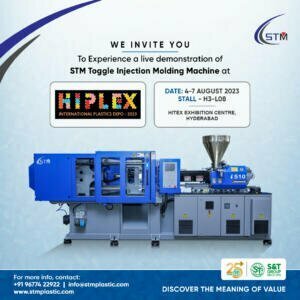Injection Molding: –
A manufacturing process for producing identical parts by injecting molten material into a mould. Injection moulding can be performed with a host of materials mainly including thermoplastics, thermoset, silicone, metal, ceramic etc.
Advantages: –
- The principal advantage of injection molding is the ability to scale production
- Once the initial costs have been paid the price per unit manufacturing is extremely low
- Injection molding machines are extremely efficient and reliable.
Types of Injection Molding Machines:-
- Three platen IMMs
- All-electric
- Hybrid
- Servo-hydraulic
- Hydraulic (Ram)
- Two platen IMMs
- Multi-component IMMs
- Vertical IMM
All Electric IMM (AE-IMM):
AE-IMM is one that has at least its three main axes (clamp movement, injection, and metering/plasticating) driven by servo motors. The remaining three axes (nozzle touch, ejection, and mold-height adjustment) can still be driven by induction motors.
Hybrid IMM:
Machines that have one or more of the three main axes driven by hydraulics but do have at least one electric-driven axis are called hybrid machines. One common example of this is a hydraulic machine with servo-driven metering. The metering is the biggest energy draw (besides barrel heating) on any IMM. Therefore, it is a smart decision to at least use a servo-electric drive for the metering.
Servo-hydraulic IMM:
A servo-driven hydraulic (or servo-hydraulic) machine is a full- hydraulic IMM with a servo motor to drive the hydraulic pump. These machines often have a fixed-displacement-pump, but could also have variable-displacement-pumps (often DFEE or DFEC) with a swash-plate.
Standard Hydraulic IMM:
These machines usually have a constant-speed motor and a variable-displacement pump with a swash plate that can be adjusted by the controls to regulate the oil-volume flow of the pump, meeting the current demand of the hydraulic system. If the machine does not move at all, the pumps will still idle and waste energy
Vertical IMM:
Vertical injection molding machines function the same as traditional horizontal machines, however they are orientated to operate on the vertical axis. This type of machine is available in hydraulic, electric and hybrid executions to meet a range of customer requirements. Vertical injection molding machines require very little floor space due to the orientation of the machine. Vertical injection molding machines are particularly suited for insert molding applications. Components can be easily loaded into the mold and held in place by gravity prior to over molding. Vertical injection molding machines often incorporate a shuttle or rotary table, allowing loading and demolding within the machines cycle time.
Two Platen IMM:
Preferred choice in higher tonnage IMM category, especially when the plant layout cannot accommodate toggle design and still need bigger day-light and better mold clamp precision.
Two platen IMM are used in applications like large automotive parts (bumper, dashboard), pallets, dust-bin, television back cover etc. Two platen machine is different from traditional three-platen mainly from mold clamp system front.
Multi-component IMM:
Multi-component injection moulding combines different materials or dyes to produce high-quality plastic parts. This means it can improve the design and function of products, automatically and cost effectively.






